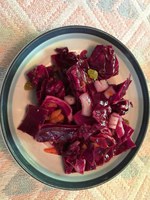Prairie Fare: Have You Enjoyed Any Anthocyanins Lately?
(Click an image below to view a high-resolution image that can be downloaded)
By Julie Garden-Robinson, Food and Nutrition Specialist
NDSU Extension Service
“What color scheme should we have this year?” I asked my older daughter as we surveyed the flower pots we needed to fill earlier this summer.
“Mom, you always get pink and purple flowers,” she replied with a grin.
Yes, she knows her mother. I usually fill my cart with pink and purple flowers. Just to show that I can be spontaneous, I planted more yellow and white flowers in the mix this year. I still have plenty of purple and pink ones, though.
I like “anthocyanins” in flower and food form. Anthocyanins (pronounced “antho-sigh-a-nins”) are the pigments responsible for the pink, purple and blue colors we are enjoying in nature right now. In some cases, purple and pink flowers can be eaten, but you might enjoy anthocyanins in fruits and vegetable form more.
Anthocyanins also are responsible for the color of red apples, red and purple grapes, red onions, red cabbage, red-skinned potatoes, purple potatoes, strawberries, raspberries, red cherries, purple plums, eggplant, blueberries and many others.
Because of advances in plant breeding, we can buy seed packets to grow purple and red carrots, purple- and pink-skinned radishes and other colorful vegetables.
I bet you can guess what I bought this year for my garden. I also planted a couple of blue potato tubers. My daughter might be surprised when she sees the colors of the vegetables we harvest.
However, not all purple and reddish foods get their color from anthocyanin compounds. Beets are colored by “betanin” and tomatoes are colored by “lycopene” pigments.
Anthocyanins are antioxidant compounds, which means they help protect the cells in our bodies from heart disease and cancer. The effect of anthocyanins on brain health is being studied.
The Nurses Study, which followed more than 93,000 women for 18 years, showed a 34 percent lower risk of heart attack among those who had three servings of blueberries or strawberries per week.
In an animal study, rats fed a red cabbage extract showed lower cholesterol levels, compared with rats not consuming the extract. Results of a human study showed lower blood pressure readings resulting from consuming more anthocyanins.
Some research has shown that blueberry extracts may improve the ability of mice to get around mazes.
Have fun adding more colorful fruits and vegetables to your menu this summer. School’s out for the summer, so here’s a science experiment about anthocyanin pigments to try at home whether or not you have kids or grandkids in your house.
Red cabbage can be used as a pH indicator. In other words, you and/or your kids can determine how acidic your favorite beverages are and whether common items in your kitchen are acidic or basic.
All you need is about 2 cups of chopped red cabbage boiled until soft in water on the stove or in a microwave oven. Then strain the cabbage through a strainer into a measuring cup.
Place small amounts of the strained liquid into separate clear glasses, then add some lemon juice (or vinegar) to one container, some baking soda to the next container and your favorite soda pop to the third. When you add soda pop, lemon juice or vinegar, the cabbage juice should turn red, indicating it is acidic. When you add something “basic” (baking soda), the juice turns bluish-purple. Check out some YouTube videos on this topic for more ideas.
Enjoy a rainbow of colorful vegetables and fruits this season to harvest all the potential health benefits. Aim for at least 4 1/2 cups of fruits and vegetables daily. Whenever possible, eat the skin of colorful fruits and vegetables to get the health benefits from the pigments.
Here’s a tasty salad that features anthocyanins (from the red cabbage, red apple, purple/red onions and cranberries) and carotenoids (from the carrots). This recipe also is rich in vitamin C (with 35 percent of the daily recommendation) and vitamin A (with 25 percent of the recommendation).
Red Cabbage Salad
1/2 c. apple cider vinegar
3 Tbsp. sugar (or honey)
1/3 c. canola oil or olive oil
2 tsp. celery seed
4 c. red cabbage, coarsely chopped
1 c. apple, unpeeled and chopped
1/2 c. carrots, grated
1/2 c. purple/red onion, chopped
1 c. golden raisins or dried cranberries
Black pepper to taste (freshly ground, if desired)
Prepare the dressing by mixing together vinegar and sugar until the sugar dissolves. Add oil and celery seed and mix well. Set aside. Rinse vegetables and fruit; prepare as described. Add raisins or dried cranberries. Add vinegar mixture and toss until well coated. Add pepper if desired. Refrigerate until serving.
Makes 10 servings. Each serving has 150 calories, 7 grams (g) fat, 1 g protein, 21 g carbohydrate and 15 milligrams sodium.
(Julie Garden-Robinson, Ph.D., R.D., L.R.D., is a North Dakota State University Extension Service food and nutrition specialist and professor in the Department of Health, Nutrition and Exercise Sciences.)
NDSU Agriculture Communication - June 29, 2017
| Source: | Julie Garden-Robinson, 701-231-7187, julie.garden-robinson@ndsu.edu |
|---|---|
| Editor: | Ellen Crawford, 701-231-5391, ellen.crawford@ndsu.edu |



